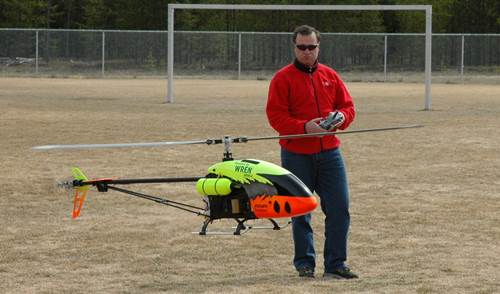Blade mQX Review – A Micro Quad Rotor That Over Delivers
by John Salt
 Flying The Blade mQX
Flying The Blade mQXThe Blade mQX (micro quad rotor with the “X” referencing Blade's AS3X electronic stabilization system).
The big difference of course with the mQX is this was Blade's
first ever quad rotor heli. If you are unfamiliar with quad rotor or
quadrocopter design and how they work,
click here
to learn more about them.
Blade had come out with some pretty exciting product over the past year that is using their micro sized AS3X stabilization system that detects and corrects for all 3 axis of flight (yaw, pitch, and roll) movement. Putting this sophisticated yet low cost electronic stabilization system on a quad rotor was an obvious choice, but what I didn’t stop to consider is just how fun this quad rotor heli could be.
I purchased this thing for the simple reason I knew I was going to be getting lots of questions on it, not thinking for a moment it could actually be fun to fly. Boy was I wrong! The Blade mQX pretty much exceeded every expectation I had. This really is a product that Blade under promised and over delivered on in my opinion.
Blade mQX - The Design
Like most other quad rotor helis, Blade’s mQX uses a conventional cross shaped frame made from square carbon fiber rod with the motors and propellers on each end. The Blade mQX uses 4 small but efficient coreless brushed motors on each corner with reduction gears and 136mm props. Blade has colored two of the props white and two black.
One would think this is their way to differentiate between the clockwise and counter-clockwise specific blades, but that is not the case.
The white blades are used as a visual in flight reference aid to help show which direction the little quadrocopter is pointed. It is therefore very important to check the underside of the blades during a prop replacement to ensure the blades labelled “A” are installed on clockwise spinning shafts (R/F & L/R) and the blades labelled “B” are installed on the counter-clockwise spinning shafts (L/F & R/R).
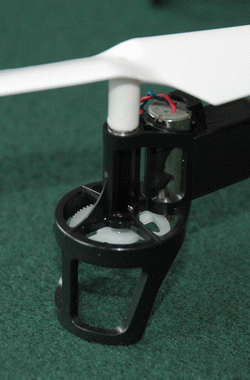 Blade mQX Motor & Gear Protection
Blade mQX Motor & Gear ProtectionAll four prop shafts are made from 3mm carbon fiber rod and are supported in the motor housing by an upper and lower ball bearing. The four motor housings also double as the landing pads and are nicely designed to protect the gearing from impact damage as well.
Replacement of the carbon thrust booms and motor assemblies is a very quick process. The booms simply slide out of the mounting frame and all four have individual plugs for the wiring, both on the circuit board end and motor end. In short, repairs should something break are very easy and quick.
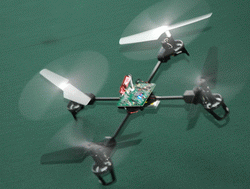 mQX Built In Training Gear
mQX Built In Training GearOne other nice thing to consider if this is your first RC helicopter or first quadrocopter is you don’t need separate training gear.
The quad design basically doubles as cross type training gear helping to prevent tip-overs.
Following all four carbon motor support booms inward toward the middle and we find the center mounting frame where the 4-in-1 circuit board is mounted. This little circuit board has a lot of technology crammed onto it just like all of Blades micro boards with the AS3X system. There is of course the DSM2 receiver built into this circuit board, the mixers for correct power distribution to the four motors along with the very sophisticated AS3X system.
One very interesting and unique feature that is allowed with this board is you have the option to fly in two different orientations/modes. Out of the box, it comes set for operation so all flight commands are oriented in a more conventional quad rotor configurations with the props in an “X” configuration out on all four corners. You can however change the “X” software to allow for a “+” flying orientation by binding the mQX with the rudder stick moved full right. When in the “+” configuration the blue LED on the circuit board blinks a 3 pulse/pause sequence as a nice visual indicator to let you know what flight mode it’s in. To get back into “X” flight, rebind with the rudder stick now fully to the left and the LED will light solid blue.
Under the frame there is the battery cradle that is designed to fit Eflite’s 500 mAh 1S 12C micro LiPo packs (the same pack that is used in the Blade 120SR). There is certainly provision for cutting the cradle off and using the flat cross section of the frame to attach different size and capacity LiPo’s with Velcro. The mQX uses a standard JST battery plug so there are lots of options when it comes to LiPo packs for this micro quad.
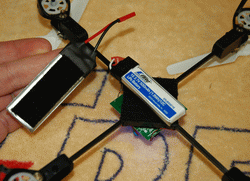 Blade mQX Battery Mod
Blade mQX Battery ModI have cut my battery cradle off and just use Velcro now so I can use 1S packs of different capacities. I found the cradle for example didn’t grip the stock 500 mAh 1S cell that well and it would slide around during a flight – this won’t happen with the Velcro but everyone will have different ideas of what the best battery mounting method may be.
To cap things off, there is a (somewhat funny looking) body cover that snaps onto the four carbon rods. This body is made from very thin and flimsily polycarbonate that although very light is also very fragile. Any blade strike will shred it to pieces – don’t ask how I found out. This body as far as I’m concerned is the only weak spot on an otherwise wonderful little quad rotor.
I personally think a foam body would better protect the circuit board or better yet a more robust clear or high visibility plastic dome encasing the top of the circuit board along with a bottom cover to keep moisture/debris out. Visual orientation was also made difficult by the silver colored body that against a grey sky, was hard to see.
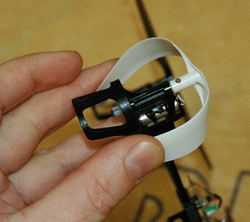 Blade mQX Flexible Prop
Blade mQX Flexible PropOther than the flimsy and fragile canopy, the rest of the Blade mQX is tough and can take a fair amount of punishment. The propellers are very flexible and the carbon thrust booms and motor mounts are strong. The Blade mQX only weighs 78g so impact energy remains low.
Like all of Blade’s helicopters, the mQX was available in two configurations:
- Bind-N-Fly (BNF) For people who have a DSM2/X radio already.
- Ready To Fly (RTF) That includes a basic 4 channel DSM2 radio.
FLIGHT PERFORMANCE – AEROBATICS ANYONE!
With the dry material out of the way, now it’s time to have a little fun. I really couldn’t wait to write this review on the Blade mQX after flying it. It’s been such a blast from the first time it lifted off the pool table indoors to a week later when the Rocky Mountain mid winter weather finally cooperated enough to take it outside and really see what it was capable of – it can do much more than I expected!
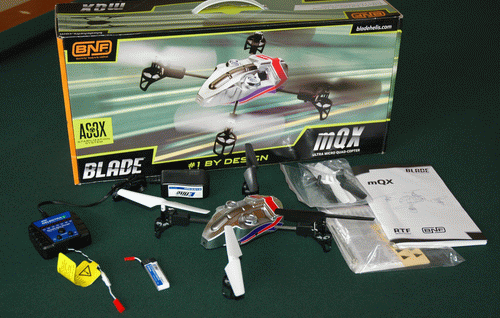 Blade mQX BNF Kit
Blade mQX BNF KitI got the BNF version of the Blade mQX of course so I could bind it to my JR X9503 or one of my Spektrum computerized radios. The setup process is as simple as a 4 channel coaxial. There are no surprises at all. Blade recommends using airplane mode to help make the setup even easier (no throttle curves to program), but as many of you know, I like to use Heli mode, even with these simple 4 channel fixed pitch setups so I can alter the throttle curves for improved hover resolution – more on that in just a bit.
After the simple setup and some very basic dual rate programming
the first surprise was just how stable it was the instant it lifted off
the pool table. Quadrocopters by their very design can be a super stable
platform (why they are so popular for aerial photography) as long as
the electronics on board are up to the task of keeping them stable. Was
the AS3X system really capable of taming a quad – yep! It’s hands off
hovering almost as easy as a micro coaxial. Where the difference lies
however is during flight.
 Blade mQX In Fast Forward Flight
Blade mQX In Fast Forward FlightDue to the AS3X heading lock gyro technology, if you tilt the Blade mQX forward at 10 degrees for example, it will lock onto that forward pitch setting until you give it a counter correction to level out and stop moving.
Like the Blade mSRX or any collective pitch heli, the Blade mQX therefore requires active piloting, but not to the same extent as those harder to fly RC helicopters. My wife can fly the mQX no problem and the only other heli’s she can fly well are the micro coaxials so that’s a good indicator of how stable and easy the mQX is. On the flip side of the coin, it can fly very quickly in all directions yet remains super stable.
 My mQX Normal Throttle Curve
My mQX Normal Throttle CurveIf you bind your Blade mQX to a computerized radio as I have done, it’s really easy to come up with very docile flying settings. As you can see, I like to use a smoothed out center throttle curve to improve throttle stick resolution in the mid area for improved fine lift control.
For tame indoor flight I like to use these Dual/Expo rates:
- Elevator: DR = 45% / Expo = +40%
- Aileron: DR = 45% / Expo = +40%
- Rudder: DR = 90% / Expo = +60%
For Outdoor Flight:
- Elevator: DR = 100% / Expo = +60%
- Aileron: DR = 100% / Expo = +60%
- Rudder: DR = 100% / Expo = +60%
One thing I did find that took some getting used to is orientation acquisition. Quad rotor helis look and are symmetrical in the air and it’s easy to forget which way they are pointed. That is where the white blades on the front half do help out. The body at a distance just doesn’t have enough contrasting shape and color difference to let you know which way the mQX is pointing so you will likely find yourself looking for those two white rotor discs but they are hard to see sometimes.
I would personally like to see small high output different color LED’s on the ends of each motor housing or at least a very high contrasting/florescent color body, propeller color, or motor housing color from front to back or side to side to aid in orientation acquisition. In the event of disorientation and the subsequent ground kiss, the Blade mQX’s current protection like all of Blade’s latest generation micro helicopters is very good. Any sudden impact of any of the four propellers will immediately shut down power to protect the motor and circuitry on the 4-in-1 board. That said, anticipating an impact and cutting power before hand is the best & safest approach.
Insane flight times!
The next surprise and this is a big one is flight time out of that little 500 mAh cell.
13 plus minutes with docile flying if you fly to LVC (low voltage cut off).
I of course don’t recommend that at all because it’s going to quickly ruin your LiPo , but it’s easy to get 10 minute flights without going much past an 80% discharge.
Quadorocopters in other words are very efficient. All their power is going towards lift with no power hungry tail rotor using up a fair amount of juice.
For those of you who have my mSR/X/120SR ebook , you know I don’t like that Eflite 500 mAh 12C pack at all for the 120SR.
It gets so hot and is short lived with that low 12C discharge rate. However, it’s perfectly matched for the Blade mQX. It barely gets warm once again demonstrating just how efficient quads are.
The Blade mQX also has an impressive climb out rate and lifting capacity. I have flown mine with up to 1000 mAh LiPo’s and it had no issues lifting the weight and talk about long flight times – wow.. 20 minutes plus! Due to the good efficiency and lifting potential, some people are mounting micro video cameras on their mQX’s with good results.
I’m not into aerial photography/video myself, but I know a lot of folks who like that aspect of the hobby and the Blade mQX is perhaps the only way to get your hands on a fairly decent performing vertical lift platform for very little money. I have tested the lift capacity of the mQX and the most it can lift reasonably well is about 50g (battery & payload). Any more than that is too much and the Blade mQX will be working too hard.
The stock 500 mAh 1S battery weighs in at about 15g so if you’re looking for a micro video camera, make sure it’s under 35g.
The 1000 mAh 1S packs I fly with are 28g so the performance as I said with them is very good. No one really needs 20 minute flight times of course, but I have never been able to fly any RC aircraft (heli or fixed wing / fuel or electric) for that long a time frame so it’s pretty cool that this low cost micro quad rotor can pull it off easily.
If you're just learning to fly, long flight times like these are very beneficial with less battery change interruptions. The Blade mQX is definitely a good RC helicopter training aid! From very docile indoor flight to advanced outdoor flying & simple aerobatics - I honestly can't think of one other RC helicopter that has the same easy to advanced performance window that this thing has.
Aerobatics, the biggest surprise of them all!
If you have looked at my quadrocopter write-up , one of the things I mentioned is that quad rotor helis are not capable of performing aerobatics, at least any of the lower cost hobby variety ones. The main reason being of course is you can’t reverse the rotor pitch when inverted to sustain inverted flight.
Well, the Blade mQX has broken this notion and for a little quad rotor that costs under $140 bucks, that is hard for me to believe. The sustained inverted flight limitation still holds true for the Blade mQX, but it can perform fast loops, rolls, and flips, where it’s not inverted for long. No, the maneuvers may not look all that pretty, but they sure are a hell of a lot of fun to execute and watch!
 My mQX Stunt Throttle Curve
My mQX Stunt Throttle CurveI use a slightly modified sport throttle curve when flying acro with the Blade mQX. I have about 7% at low stick as you can see so the rotors won’t completely shut down while pulling full low throttle when inverted. You definitely do want to reduce rotor RPM the instant you are inverted or the little Blade mQX will suck its ways towards the ground very rapidly and you will lose altitude very quickly for the small amount of time you are upside down.
Blade doesn’t even mention the mQX is aerobatic in any of it’s promotional literature, so you can only imagine my surprise when I took mine outside and after seeing how responsive the cyclic (not really cyclic on a quad so maybe we should go back to aileron and elevator) was, I decided to get 30 feet or so up in the air and pull full rear stick.
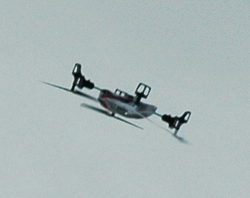 Blade mQX Inverted
Blade mQX InvertedTo my amazement it flipped upside down in a blink and rotated back out into upright flight without even loosing that much altitude.
I thought it was a fluke at first and only after trying several more flips (both forward and backward) did I realize this thing is fully aerobatic.
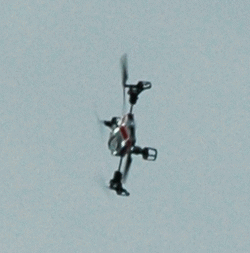 Blade mQX Rolling
Blade mQX RollingI was grinning ear to ear and couldn’t stop there. It was roll time and rolls were just as easy. All this fun and 10 minute flights to boot! After further reading the instructions (maybe something I should have done before flying it) I did see on page 11 where it mentions one of the more experienced things to try is "flips and rolls". This is again why I mentioned Blade really did over deliver and under promise on this little micro quadrotor mQX.
Blade mQX acro abilities aside, the mQX is just at home outdoors as it is indoors. It’s actually has one of the largest foot prints in Blade’s micro line-up for the simple reason it’s fairly big. Propeller to propeller tip is almost 14” or 350mm so that is a fairly large micro sized birdie hanging up there. Wind immunity was also very good.
Blade state it’s able to handle some wind, but it’s always a mystery just how much. During the outdoor photo shoot I had my wind meter and there were the odd 10kph gusts coming through with a fairly steady 3-4 kph breeze. It was really neat to see how the mQX would keep fairly still. Flying in the wind introduces some bobbles and wobbles just like on the Blade mSRX or mCPX, but that’s about it.
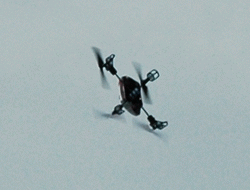 Blade mQX Diving
Blade mQX DivingThe one thing I did have to get used to in wind with this little micro quad is how low you have to lower the throttle while in translational lift to loose altitude.
This thing is so light weight, and that along with 4 high lift rotors keep giving lift in wind almost to the point you are powered all the way down to come back to mother earth. Just keep that in mind if you do go out on a windy day before getting used to the translational lift characteristics on the Blade mQX. I would hate to see your new birdie get lofted a hundred feet and taken for a long downwinder into hostile territory – you know, the hungry jaws of the neighbors 125 lb Rottweiler (don't ask).
Blade mQX Specs.
- Heli Type: Micro Quadrocopter (quad rotor)
- Stabilization: Electronic micro 3 axis gyro AS3X
- Number of Channels: 4 (throttle, rudder, aileron, elevator)
- Radio Compatibility: All Eflite, Spektrum & JR 4 channel and higher that use DSM2 protocol, or Futaba with Spektrum DSM2 RF modules.
- Motor Type: Coreless Brushed (x4)
- Bearing Count: 8 (2 per motor nacelle)
- Construction: Plastic & Carbon
- Power Requirements: 1S LiPo, JST plug, 500mAh (can handle up to 1S 1000 mAh)
- Flying Weight with Stock 1S 500 mAh LiPo: 78g (2.75 oz)
- Propeller Diameter: 136mm (5.35”)
- Length from motor housings: 245mm (9.65”) Apx. 250 size quad-rotor.
- Height: 59mm (2.32”)
FINAL (2023 updated) THOUGHTS
When Blade released the mQX, there really was nothing else out there in the same price range that could do what the Blade mQX could. That of course in no longer the case these days with many small fully aerobatic hobby grade RTF micro quad rotors being sold in the $30 range.
At the time, the mQX certainly exceeded my expectations with the weakest link being the flimsy body cover. I admit now, quad rotors don't do much for me anymore as they are too easy to fly and don't engage me in the least.
The potential for future development with this thing was hard to imagine at the time. Blade had a real winner and it was interesting to see in the coming years what other quad offerings they came out with. This was the start of quad rotor revolution for Blade after all, and then they started the several year run with many models from beginner, right up to full on advance FPV racing models. Then as quickly as they got into quad-copters, Blade got out of them focusing once again on helicopters only.
It's still nice to look back knowing it all started with the humble little mQX :-)







